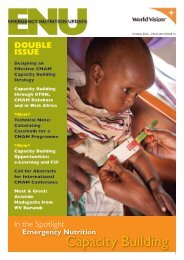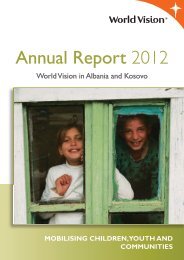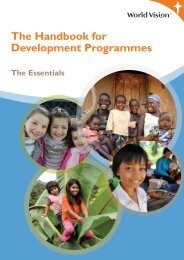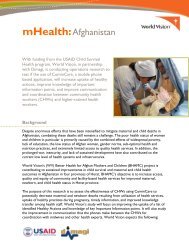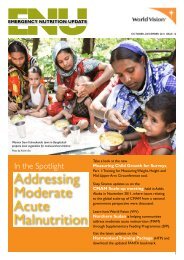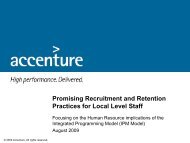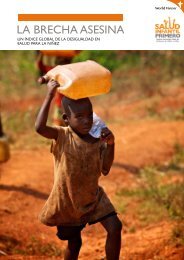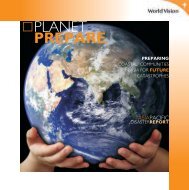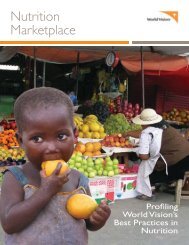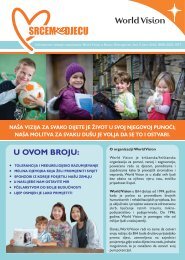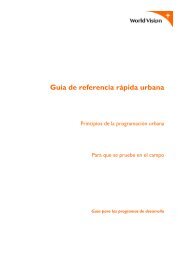the right to inclusive education for children with disabilities
the right to inclusive education for children with disabilities
the right to inclusive education for children with disabilities
Create successful ePaper yourself
Turn your PDF publications into a flip-book with our unique Google optimized e-Paper software.
democracy, new notions and concepts were introduced regarding <strong>the</strong> treatment and <strong>the</strong> place which <strong>the</strong>special <strong>education</strong> should take.The special period of that time, put <strong>the</strong> government, <strong>the</strong> <strong>education</strong>al institutions and community be<strong>for</strong>esome necessary obligation, regarding <strong>the</strong> creation of opportunities that <strong>children</strong> <strong>with</strong> <strong>disabilities</strong> be educatedin equal conditions <strong>with</strong> those of <strong>the</strong>ir peers.In this period, <strong>the</strong> problems and needs of <strong>children</strong> <strong>with</strong> <strong>disabilities</strong>, became first known <strong>for</strong> <strong>the</strong> public. Mediabegan speaking of <strong>the</strong>m, <strong>the</strong> first associations were established. A movement began aiming at modificationand trans<strong>for</strong>mation of <strong>the</strong> Albanian mentality about <strong>children</strong> <strong>with</strong> <strong>disabilities</strong> and <strong>the</strong>ir families. These changeswere associated <strong>with</strong> <strong>the</strong> opening of state borders <strong>to</strong> <strong>the</strong> Western countries and <strong>the</strong> facing of Albanians<strong>the</strong>re<strong>for</strong>e <strong>with</strong> ano<strong>the</strong>r reality. The first non governmental associations that were <strong>for</strong>med, began <strong>to</strong> address<strong>the</strong> complex needs of <strong>children</strong> <strong>with</strong> <strong>disabilities</strong>. In o<strong>the</strong>r words, <strong>the</strong> change started at <strong>the</strong> mentality of civilsociety, which was later followed by <strong>the</strong> modification of professionals’ expectations <strong>for</strong> individuals <strong>with</strong><strong>disabilities</strong> <strong>to</strong> arrive at <strong>the</strong> reflection of <strong>the</strong>se changes in government policies. An important point thatshowed <strong>the</strong> change of state policy, was <strong>the</strong> devolution of competences from institutions operating in <strong>the</strong>field of disability under MoH <strong>to</strong> MLSAEO in 1993.In this period, <strong>the</strong> first integration practices that made possible <strong>the</strong> integration of some students <strong>with</strong><strong>disabilities</strong> in classrooms of basic <strong>education</strong> alongside <strong>the</strong>ir peers, began <strong>to</strong> be implemented. The integrationof <strong>the</strong>se <strong>children</strong> <strong>with</strong> <strong>disabilities</strong> in school and social life, came as a necessity of development of integration ofsociety. Generally speaking, <strong>the</strong> integration is considered <strong>to</strong> be one of <strong>the</strong> major re<strong>for</strong>ms of society in its steps<strong>to</strong>wards progress. It affects not only persons <strong>with</strong> <strong>disabilities</strong>, but <strong>the</strong> entire society, each and every citizen, <strong>to</strong>avoid <strong>the</strong> serious consequences of isolation.The process of integrating <strong>children</strong> <strong>with</strong> <strong>disabilities</strong>, is facilitated by feelings of solidarity that Albaniansociety had inherited from family support, and <strong>the</strong> benevolence of <strong>the</strong> employees of <strong>education</strong>. But <strong>the</strong>lack of a legal framework <strong>to</strong> open <strong>the</strong> path of integration process of <strong>children</strong> <strong>with</strong> <strong>disabilities</strong>, has sloweddown this process.Despite <strong>the</strong>se ef<strong>for</strong>ts, <strong>the</strong>re were many issues in terms of financial, material and human resources. Lifecharacteristics and features of <strong>the</strong> Albanian society: poverty, isolation, lack of infrastructure, unemployment,<strong>the</strong> cost of health services, migration and prejudice, created difficulties in realizing <strong>the</strong> process of integrationof disabled <strong>children</strong> in <strong>the</strong> learning process.This process received strong support from many national and international non-governmental organizations,such as: Children’s Aid Direct (CAD), UNICEF, Save <strong>the</strong> Children, MEDPAK, Shoqata Kombëtare eHanikapëve Mendorë, FSHDPAK, Ndihmoni Jetën, Organizata e të Verbërve, ANAD (Association of people<strong>with</strong> hearing impairment). This process was partly reflected in <strong>the</strong> government policy of that time. It maybe pointed out that <strong>the</strong>re were concrete positive ef<strong>for</strong>ts by <strong>the</strong> governmental structures on <strong>the</strong> <strong>right</strong>sof <strong>children</strong> <strong>with</strong> <strong>disabilities</strong>, after <strong>the</strong> official signing of <strong>the</strong> International Convention on <strong>the</strong> Rights of <strong>the</strong>Children, in February 1992. These <strong>right</strong>s were reflected in <strong>the</strong> relevant legal acts. In that scope, it’s worthmentioning <strong>the</strong> adoption of Law no. 7952, dated 06.21.1995 of <strong>the</strong> Constitution of <strong>the</strong> Republic of Albania,<strong>for</strong> <strong>the</strong> pre-university <strong>education</strong>al system, which <strong>for</strong> <strong>the</strong> first time declared that:article 3: Citizens of <strong>the</strong> Republic of Albania, enjoy equal <strong>right</strong>s, <strong>to</strong> be educated at all levels of <strong>education</strong>... regardless of social status, health ... and economic level.article 39: Public Special Education is an integral part of <strong>the</strong> public <strong>education</strong> system in <strong>the</strong> Republic ofAlbania. Public Special Education aims that through <strong>the</strong> use of specific <strong>for</strong>ms and methods <strong>to</strong> ensure <strong>the</strong>fullest possible development of opportunities <strong>for</strong> people <strong>with</strong> physical, mental or emotional impairments, inaccordance <strong>to</strong> <strong>the</strong>ir needs and requirements <strong>for</strong> a life <strong>with</strong> dignity.This law was specified in <strong>the</strong> Normative Provision of <strong>the</strong> time <strong>for</strong> public schools, approved by <strong>the</strong> Ministryof Education, and which obliged <strong>the</strong> responsible authorities <strong>to</strong> implement it. In regard <strong>to</strong> <strong>children</strong> <strong>with</strong><strong>disabilities</strong>, <strong>the</strong> NP in question allowed <strong>the</strong>ir <strong>education</strong> in both special schools and in mainstream schools. Theexact quotation:32 The <strong>right</strong> <strong>to</strong> Inclusive Education <strong>for</strong> <strong>children</strong> <strong>with</strong> Disabilities



